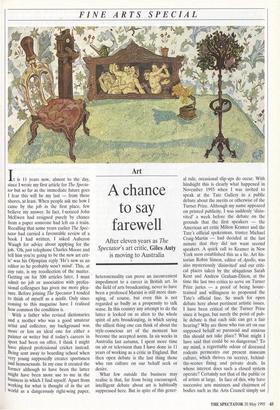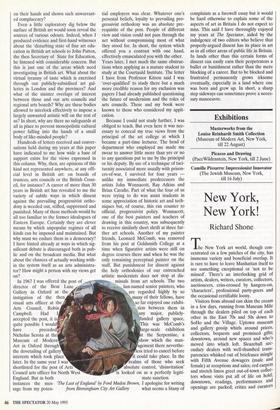FINE ARTS SPECIAL
Art
A chance to say farewell
After eleven years as The Spectator's art critic, Giles Auty is moving to Australia It is 11 years now, almost to the day, since I wrote my first article for The Specta- tor but so far as the immediate future goes I fear this will be my last — from these shores, at least. When people ask me how I came by the job in the first place, few believe my answer. In fact, I noticed John McEwen had resigned purely by chance from a paper someone had left on a train. Recalling that some years earlier The Spec- tator had carried a favourable review of a book I had written, I asked Auberon Waugh for advice about applying for the job. 'Oh, just telephone Charles Moore and tell him you're going to be the new art crit- ic' was his Olympian reply 'He's new as an editor so he probably won't mind'. This, at any rate, is my recollection of the matter. Getting on for 500 articles later, I must admit no job or association with profes- sional colleagues has given me more plea- sure. Before joining The Spectator I tended to think of myself as a misfit. Only since coming to this magazine have I realised how common the condition is.
With a father who revised dictionaries and a mother who was a good amateur artist and collector, my background was more or less an ideal one for either a painter or writer but if today's careers in sport had been on offer, I think I might have played professional cricket instead. Being sent away to boarding school when Very young supposedly creates sportsmen and homosexuals. In my case it created the former although to have been the latter might have been more use to me in the business in which I find myself. Apart from Working for what is thought of in the art World as a dangerously right-wing paper, heterosexuality can prove an inconvenient impediment to a career in British art. In the field of arts broadcasting, never to have been a professed Marxist is still more dam- aging, of course, but even this is not regarded so badly as a propensity to talk sense. In this country any attempt to do the latter is looked on as alien to the whole spirit of arts broadcasting, in which saying the silliest thing one can think of about the style-conscious art of the moment has become the accepted norm. In six weeks in Australia last autumn, I spent more time on air or television than I have done in 11 years of working as a critic in England. But then open debate is the last thing those who run culture on our behalf seek or desire.
What few outside the business may realise is that, far from being encouraged, intelligent debate about art is habitually suppressed here. But in spite of this gener- al rule, occasional slip-ups do occur. With hindsight this is clearly what happened in November 1993 when I was invited to speak at the Tate Gallery in a public debate about the merits or otherwise of the Turner Prize. Although my name appeared on printed publicity, I was suddenly `disin- vited' a week before the debate on the grounds that the first speakers — the American art critic Milton Kramer and the Tate's official spokesman, trustee Michael Craig-Martin — had decided at the last minute that they did not want second speakers. A quick call to Kramer in New York soon established this as a lie. Art his- torian Robin 'Simon, editor of Apollo, was also mysteriously `disinvited' and our criti- cal places taken by the ubiquitous Sarah Kent and Andrew Graham-Dixon, at the time the last two critics to serve on Turner Prize juries — a proof of being house- trained and willingness to propound the Tate's official line. So much for open debate here about pertinent artistic issues. I have been critical of the Turner Prize since it began, but surely the point of pub- lic debate is that each side can get a fair hearing? Why are those who run art on our supposed behalf so paranoid and anxious this should not take place? What might I have said that could be so dangerous? To my mind, a regrettable odour of deceased rodents permeates our present museum culture, which thrives on secrecy, behind- the-scenes fixing and private deals. In whose interest does such a closed system operate? Certainly not that of the public or of artists at large. In face of this, why have successive arts ministers and chairmen of bodies such as the Arts Council simply sat on their hands and shown such unwarrant- ed complacency?
Even a little exploratory dig below the surface of British art would soon reveal the sources of various odours. Indeed, when I produced evidence and first-hand witnesses about the 'disturbing state of fine art edu- cation in British art schools to John Patten, the then Secretary of State for Education, he listened with considerable concern. But this is just one of the areas which need investigating in British art. What about the virtual tyranny of taste which is exercised through our publicly-subsidised art gal- leries in London and the provinces? And what of the sinister overlaps of interest between those and our arts councils and regional arts boards? Why are these bodies allowed to interlock effectively to impose a largely unwanted artistic will on the rest of us? In short, why are there no safeguards at all in place to prevent monopolistic cultural power falling into the hands of a small body of like-minded people?
Hundreds of letters received and conver- sations held during my years at this paper have indicated to me how wide a base of support exists for the views expressed in this column. Why, then, are opinions of this kind not represented anywhere, at any offi- cial level in British art: on boards of trustees, arts councils or the British Coun- cil, for instance? A career of more than 30 years in British art has revealed to me the variety of subtle ways in which dissent against the prevailing progressivist ortho- doxy is weeded out, stifled, suppressed and punished. Many of these methods would be all too familiar to the former idealogues of Eastern Europe. Certainly they are clever means by which unpopular regimes of all kinds can be imposed and maintained. But why must we endure them in a democracy? I have hinted already at ways in which sig- nificant debate is discouraged both in pub- lic and on the broadcast media. But what about the chances of actually working with- in the system itself as an arts administra- tor? How might a person with my views get on?
Campbell. Had I accepted the post, it is quite possible I would tial employers was clear. Whatever one's personal beliefs, loyalty to prevailing pro- gressivist orthodoxy was an absolute pre- requisite of the post. People of different view and vision could not pass through the net without compromising most of what they stood for. In short, the system which offered you a contrast with one hand, effectively emasculated you with the other. Years later, I met much the same obstruc- tions when applying as a mature student to study at the Courtauld Institute. The letter I have from Professor Kitson said I was `over-qualified' to study there but a much more credible reason for my exclusion was papers I had already published questioning the future of modernism and the roles of arts councils. These and my book were known to those who considered my appli- cation.
Because I could not study further, I was obliged to teach. But even here it was nec- essary to conceal my true views from the principal of the art college at which I became a part-time lecturer. The head of department who employed me made me swear to answer little more than yes or no to any questions put to me by the principal or his deputy. By use of a technique of taci- turnity associated more usually with prison- ers-of-war, I survived for four years unlike my immediate predecessors the artists John Wonnacott, Ray Atkins and Brian Cavallo. Part of what the four of us were trying to do was assist students in some appreciation of historic art and tech- niques but, of course, this ran counter to official, progressivist policy. Wonnacott, one of the best painters and teachers of drawing in this country, was subsequently to receive similarly short shrift at three fur- ther art schools. Another of my painter friends, Leonard McComb, was removed from his post at Goldsmith College at a time when figurative artists were still on degree courses there and when he was the only remaining perceptual painter on the staff. But punishment for dissent against the holy orthodoxies of our entrenched artistic modernists does not stop at dis- missals from art schools. The two last-named senior painters, who are regarded highly by so many of their fellows, have so far enjoyed one exhibi- tion between them in ny major, publicly- nded gallery space. his was McComb's arge-scale exhibition t the Serpentine, a show which the man- agement there neverthe- ess tried to cancel before it could take place. In the realms of those who seek absolute control, `disinvitation' is looked on as a perfectly legiti- mate sanction. complaints as a farewell essay but it would be hard otherwise to explain some of the aspects of art in Britain I do not expect to miss. This said I have thoroughly enjoyed my years at The Spectator, aided by the indulgence of two editors who believe that properly-argued dissent has its place in art as in all other areas of public life in Britain. In lands other than this certain forms of dissent can easily earn their perpetrators a bullet or banishment rather than the mere blocking of a career. But to be blocked and frustrated permanently grows irksome eventually, especially in a land where one was born and grew up. In short, a sharp step sideways can sometimes prove a neces- sary manoeuvre.



































































 Previous page
Previous page